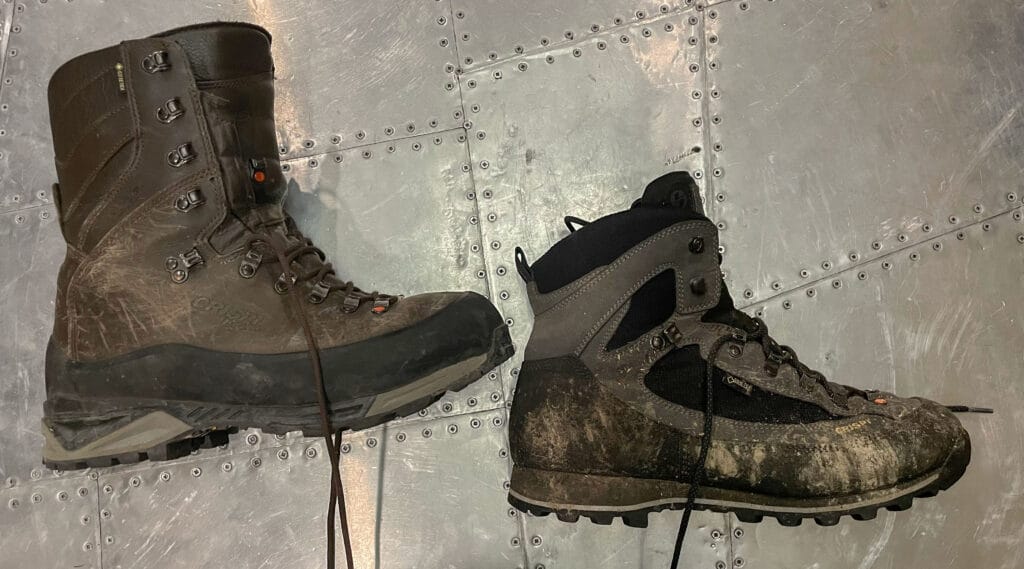200g vs 400g vs 800g Thinsulate or Primaloft in Boots: Which to pick?

Thinsulate is a type of insulation used in boots to make them warmer. I have owned a few different pairs of boots with different amounts of insulation, and there is a huge difference between them.
As a general rule, 800g of insulation (Primaloft or Thinsulate) is best for boots when the temperature is 32 degrees or less. From 32 degrees to 40 degrees, 400g of insulation is preferred for most uses. 200g of insulation is best for temperatures between 40-50 degrees. Don’t pick boots with any insulation if temperatures will be above 50 degrees.
That’s my general rule, but there’s actually a lot of nuance to deciding how much insulation to have in your boot.
Match Your Insulation Level to the Conditions–Not Necessarily the Temperature.
On a recent hunt on Kodiak Island, Alaska, the daily high temperature was 40 degrees but on days when I was standing still on the boat, it felt intensely cold because of the humidity level. I was happy to have 800g of Thinsulate in my Crispi boots, but my feet were still cold.
However, I have also hunted with those same boots (800g of Thinsulate) in Idaho when it was 40 degrees. I was walking around most of the day, and my feet were burning hot and uncomfortable. So while the general rule at the top of this post is helpful, keep in mind that it depends on your activity and conditions.
What’s the Difference Between Thinsulate and Primaloft?
Both of these insulation brands are extremely comparable as they are both well-made synthetic insulations used by many of the top boot manufacturers. I would not expect any significant difference in warmth between the brands when the same weight of insulation is included.
Thinsulate is made by 3M, and Primaloft is made by… well… Primaloft. Primaloft is a private company that originally designed its product for use by the US military in the 1980s.
Match Your Boot To Your Activity Level
Making sure you match a boot with your desired activity will be half the battle when looking for comfortable feet. Wearing a mountaineering boot into the stand in late November will not work out for you no matter how good the mountaineering boot is.
When matching a boot to an activity look at the expected weather conditions and physical activity level. Weather and temperature conditions can make a big difference for your comfort on two separate fronts while activity can help bridge gaps.
| Warm Temperature, Low Activity | Warm Temperature, High Activity | Cold Temperature, Low Activity | Cold Temperature, High Activity |
| Minimal insulation is required. Use a single layer of socks. | Minimal insulation is required. Two layers of socks can be of benefit to help move moisture and also reduce the chance of blistering. | Insulation required. The use of two sock layers will be beneficial. One layer to help move moisture and the second outer sock should be thick to help increase insulation. | Insulation required. The use of two sock layers will be beneficial. The first layer will move moisture while the second will provide some thermal protection but will mostly protect your foot from friction against your boot. |
Most people looking to buy a warm-weather boot will be focused on weight over insulation. For this reason, warm weather boots will be virtually guaranteed to be non-insulated.
As the temperature drops closer to the point of freezing most hiking/ mountaineering boots will not be insulated at this point but will have a thicker construction giving them a near insulated feel. Having a good understanding of sock layering will give you comfortable results here.
Once temperatures reach the point of 0 degrees Fahrenheit (-18 degrees Celsius) on a constant basis the choice of using a hiking or mountaineering boot against a winter pack boot is completely dependant on activity level. Personally when I sheep hunt in the latter half of the season I use my non-insulated mountaineering boots with two layers of socks that I rotate out every day to ensure that my feet are as warm and dry as possible. However when I deer hunt in November I am not hiking as much and then switch to the pack boot with 400g of insulation and once again two layers of socks.
Comfort and Temperature
Many factors contribute to having warm and comfortable feet. For many people, one person’s technique will not work for you directly. Some of the biggest factors in having comfortable feet are Waterproofing, Socks, and good Circulation.
Waterproof
Waterproofing is a rather basic and yet extremely important factor in having comfortable and warm feet. Modern Gore-Tex technology acts as a breathable waterproof layer built into many hiking/ mountaineering boots. However, Gore-Tex alone will need a little extra help especially when temperatures begin to fall.
My technique with Gore-Tex boots is to waterproof the exterior part of my boots before every major outing. I own a pair of Asolo mountaineering boots that have a leather exterior. Using a waterproofing called Nikwax I apply this to the leather to help prevent ice up when sheep hunting. Without the additional waterproofing, the Gore-Tex will keep your feet dry however the leather will absorb water and ice up.
Socks
Socks are the biggest variable that can help you with cold feet however they are more individually specific. The biggest common mistake is using a cotton sock instead of wool or synthetic material.
| Sock Liner | Lite Sock | Medium Sock | Heavy Sock |
| Sock liners have been around for several years. They work by providing a very thin layer between your skin and your primary sock. They work well for reducing friction and also moving moisture away from your foot. | Lite socks are the least insulating and least cushioning. They work well in high temperatures as well as periods of high excursion. | Medium socks are a good all-around sock that provides some insulation as well as cushioning. The vast majority of people will use this sock for both comfort and warmth. | Heavy socks are perfect for cold weather. They have the most insulation and cushioning however you can have overheating problems with these socks if you misjudge your environment. |
With advancements in socks (as funny as that sounds) many people opt out of having a sock liner and just go with one of the other three weights of socks. However, people that have issues with blistering can still utilize sock liners. Furthermore, people that are in extremely cold temperatures can benefit from the moisture-wicking of sock liners.
Caution must be taken when sock layering to ensure that you don’t size yourself out of your boots. This is potentially a problem for people switching to a heavy-weight sock.e
Circulation
One of the lesser thought of problems with cold feet is in fact circulation. Now if you’re like myself that has frozen their feet one too many times you will likely experience cold feet even in mild conditions. However, circulation can be affected when standing still, sitting in a stand, or even in a reasonably comfortable chair when ice fishing.
If you have circulation problems it will more or less require your sock game to be on point. However, for instances such as tree stands having an extra foam seat to help reduce pressure in your hamstrings can increase circulation.
Remember restricting the blood flow in your legs can lead to frozen feet. Make sure your boots aren’t done up to tight! Furthermore, if you are going to layer your socks ensure that you don’t size yourself out of your boots. Cramming your foot into a boot will guarantee frozen feet.
Conclusion
In conclusion, many people will not need to concern themselves with insulated boots and rather should focus on proper sizing and sock configurations. If you find yourself looking at a pair of well-fitting boots that have insulation I would personally go with the lighter weight insulation for hiking purely to the fact that the insulation will degrade over time.
When I do extended backcountry trips socks and foot care are extremely important! A good waterproof boot that has water treatment on the outside combined with good sock layering has never let me down.
Look for insulated boots when you’re expecting to do stationary activities such as ice fishing or tree stand hunting. However, always keep in mind moisture-wicking and circulation for best results.
